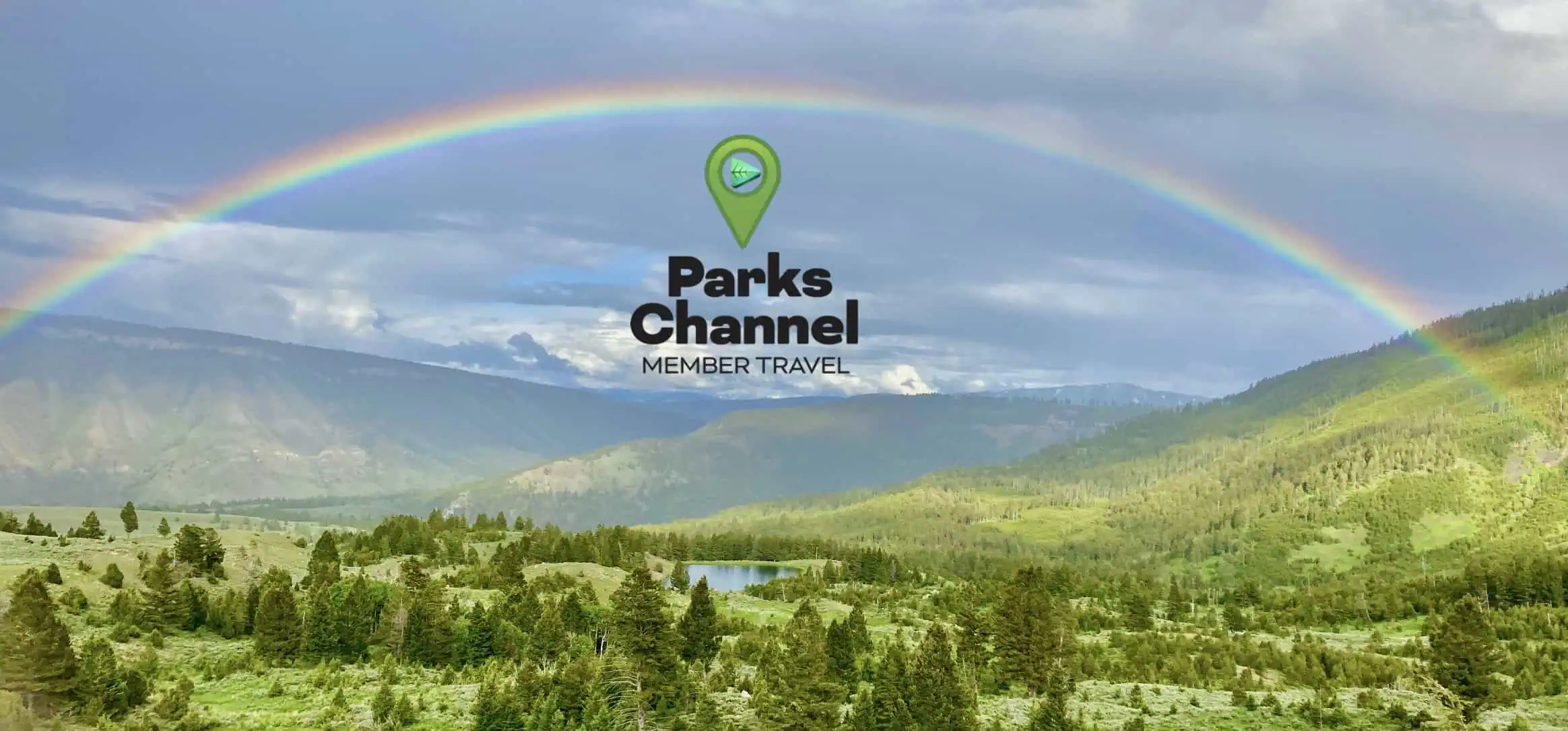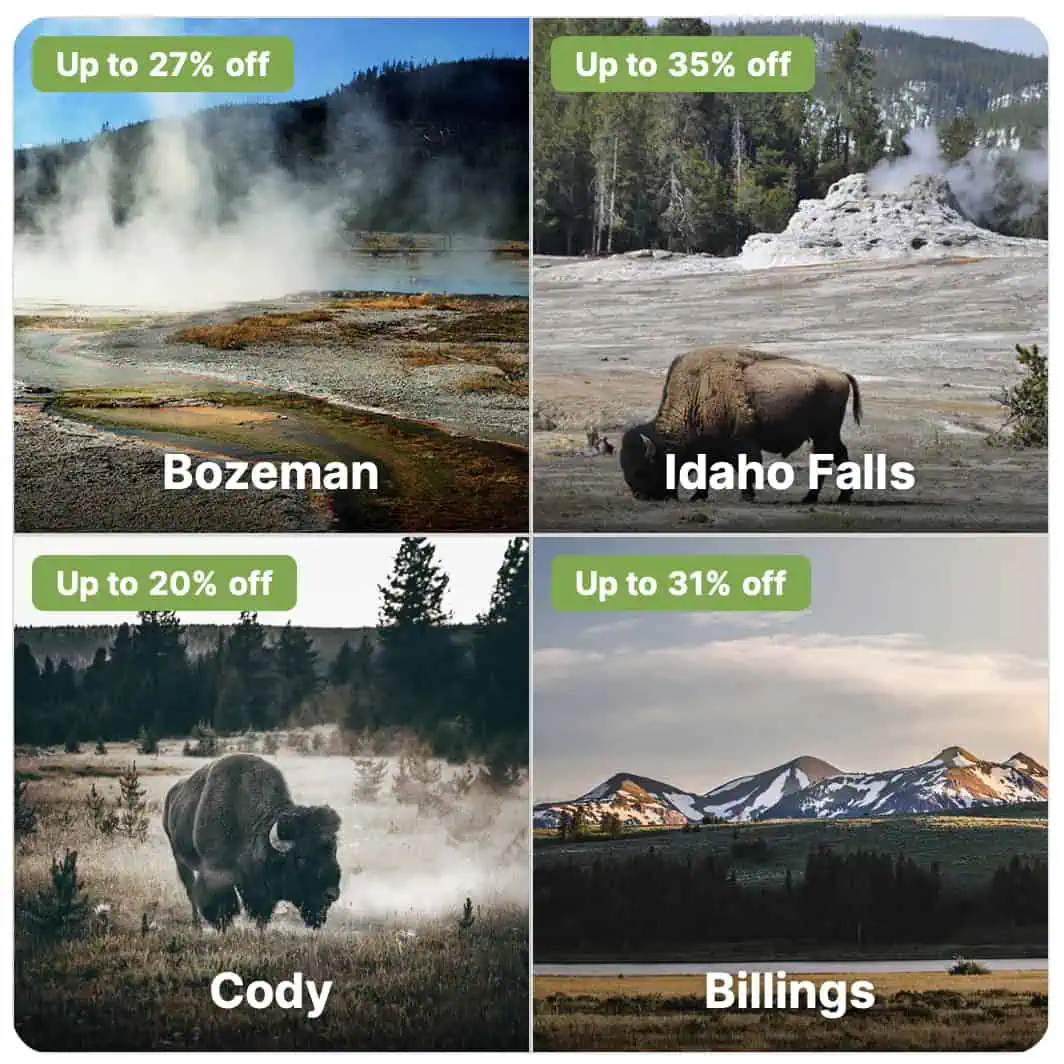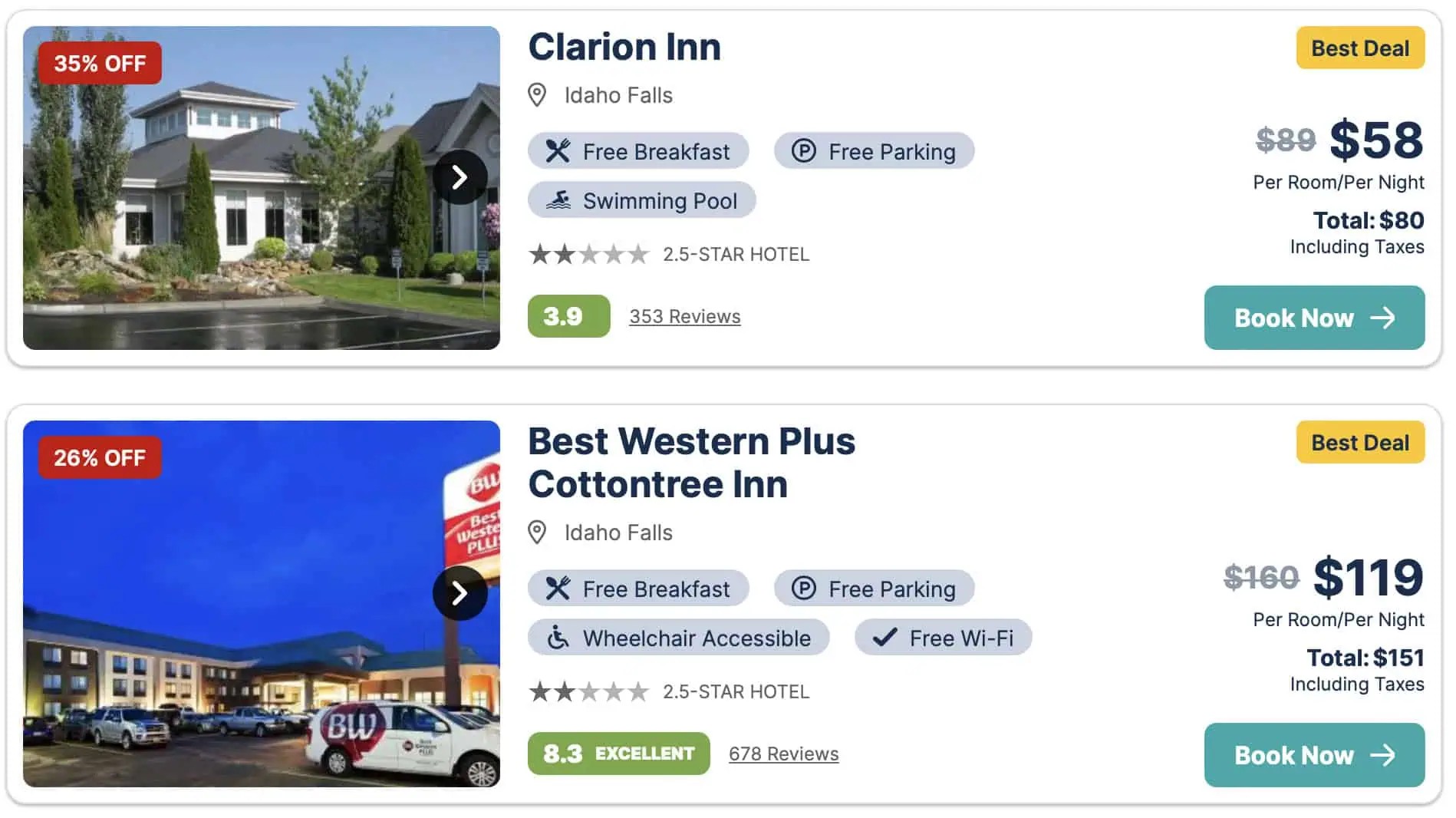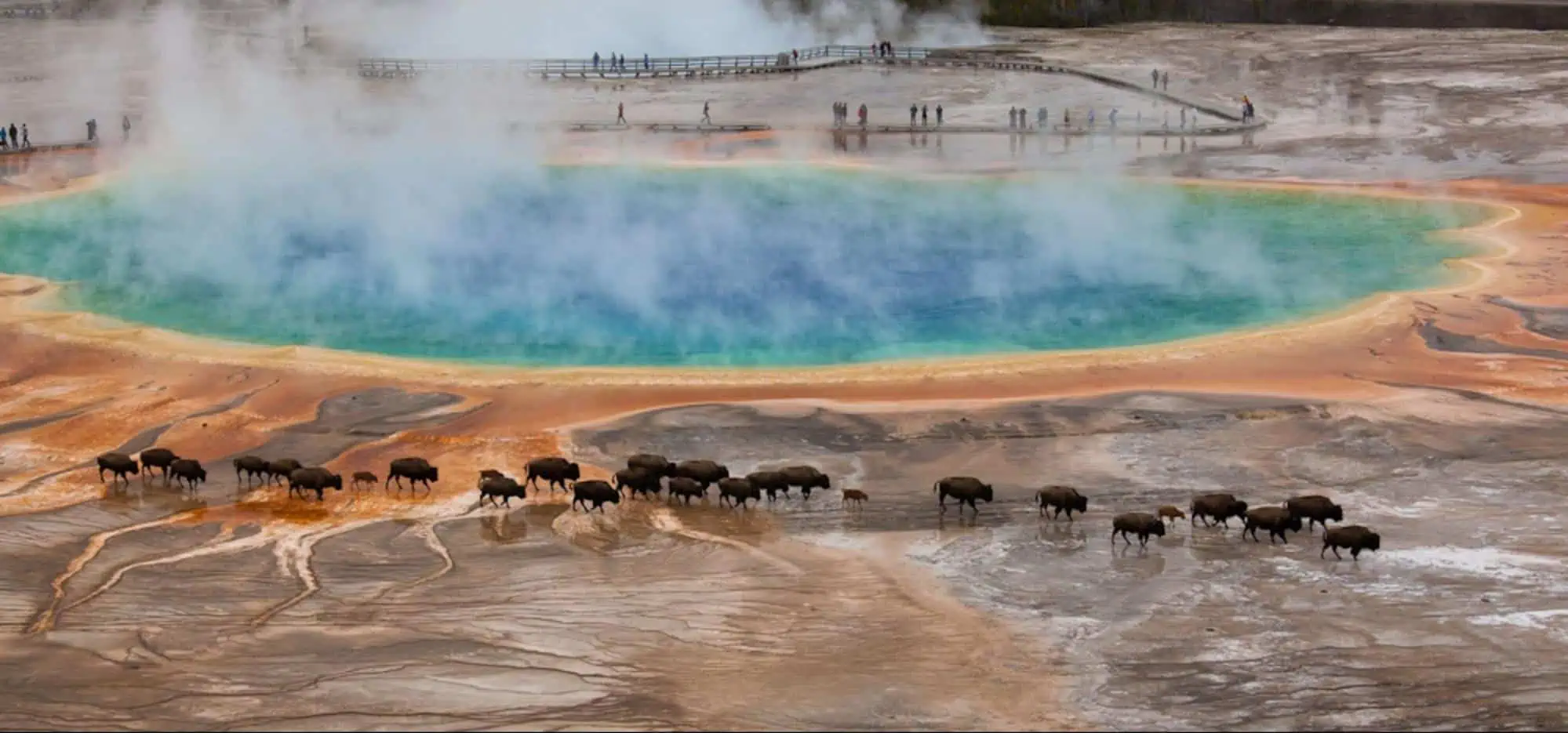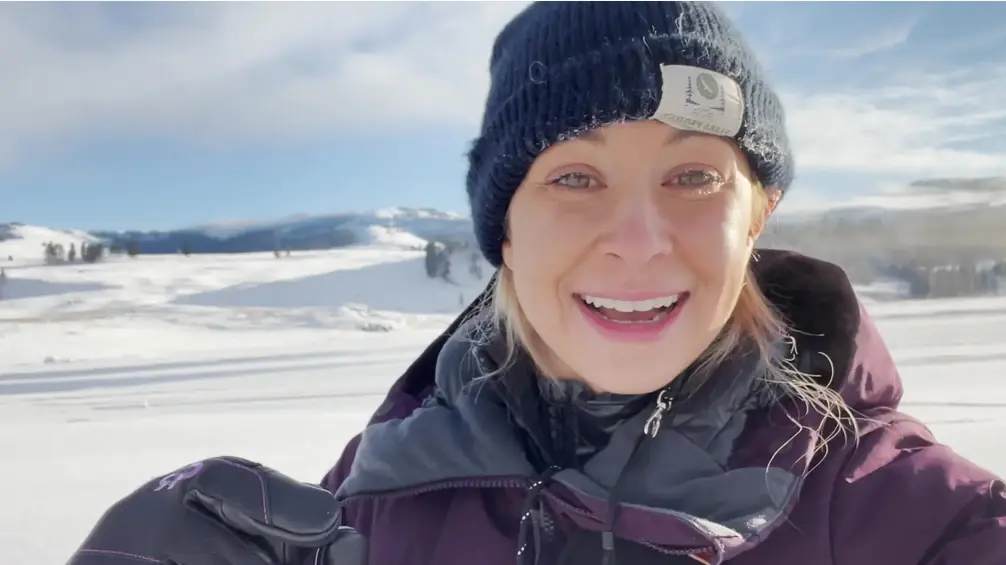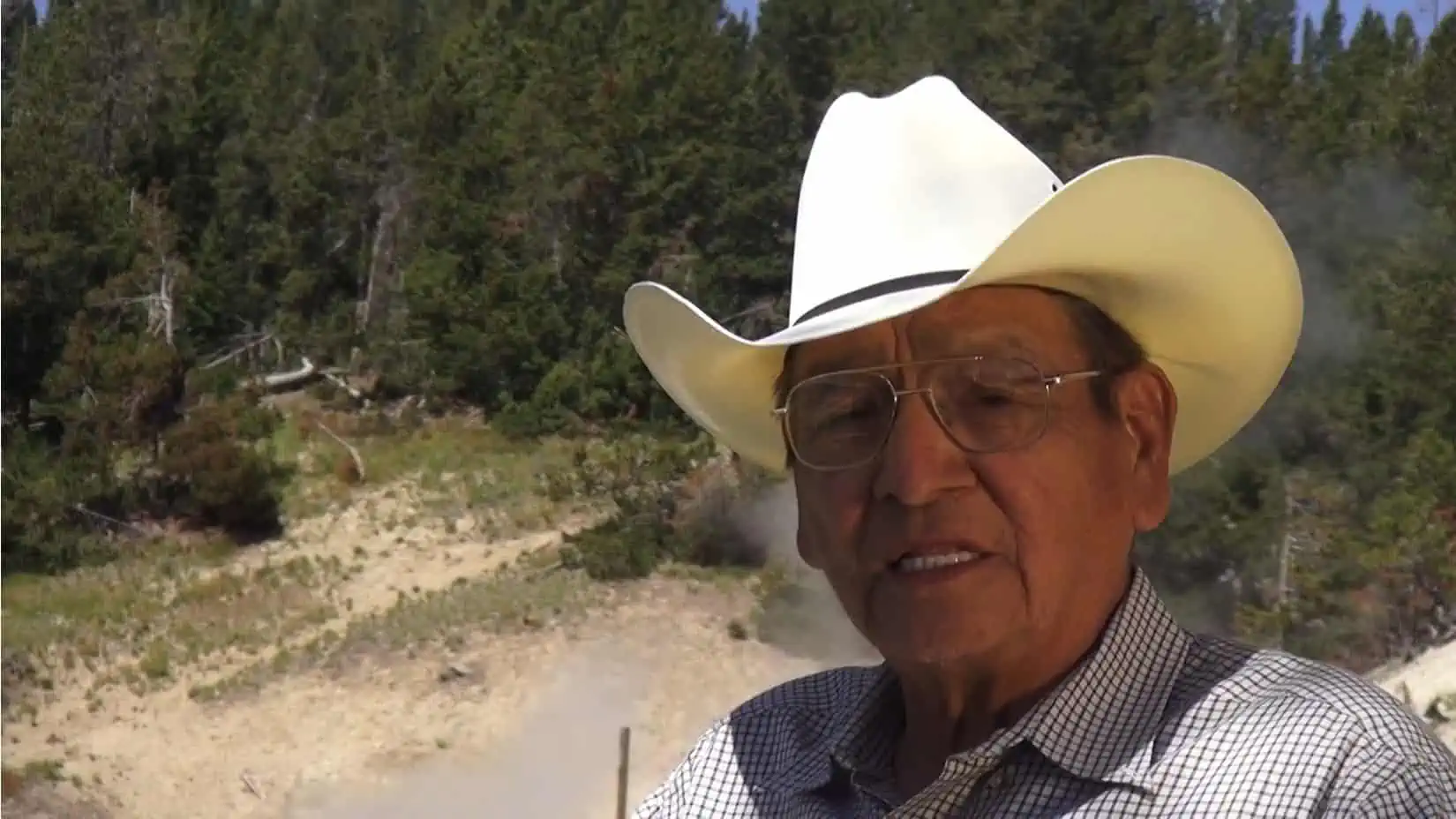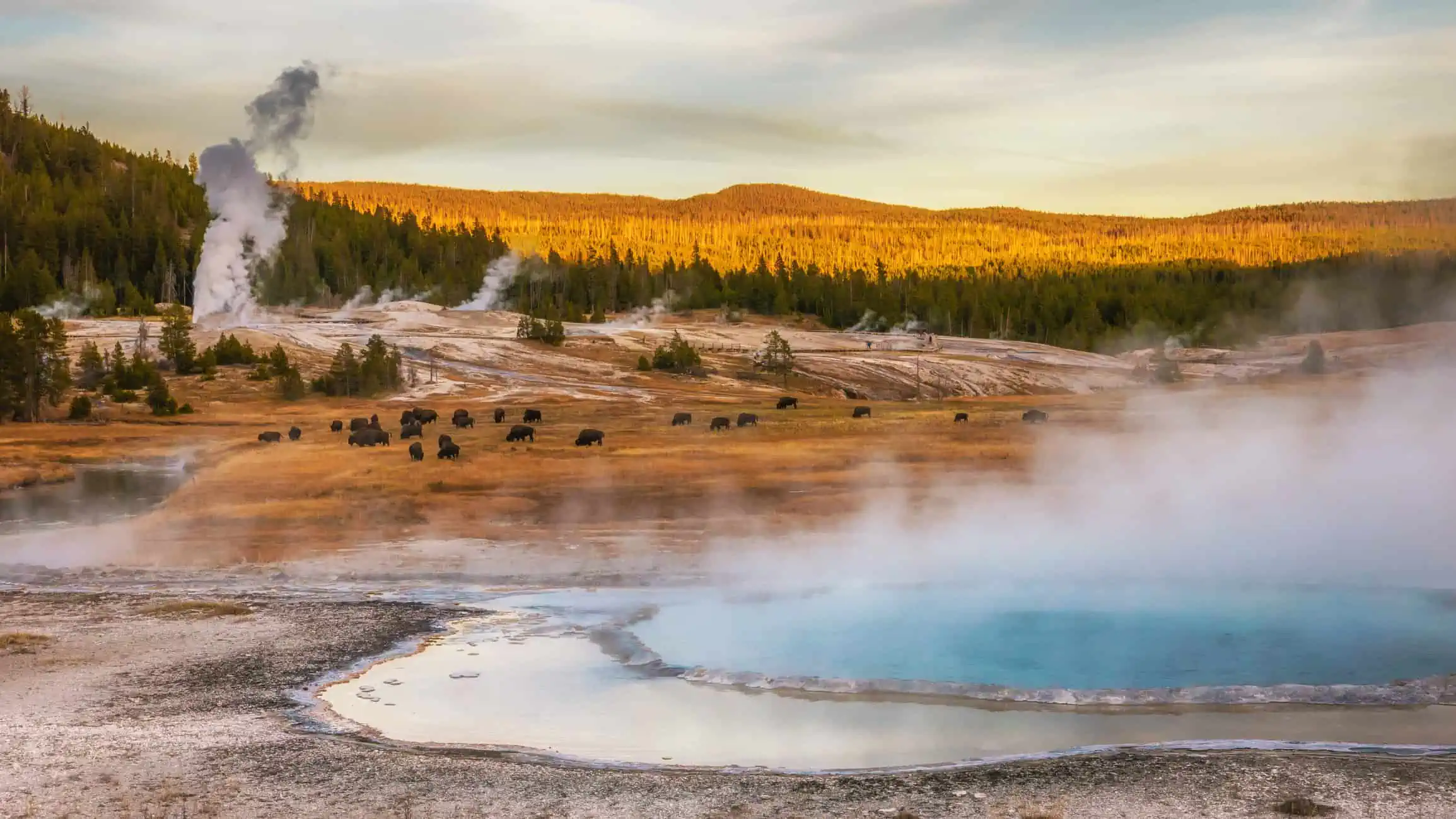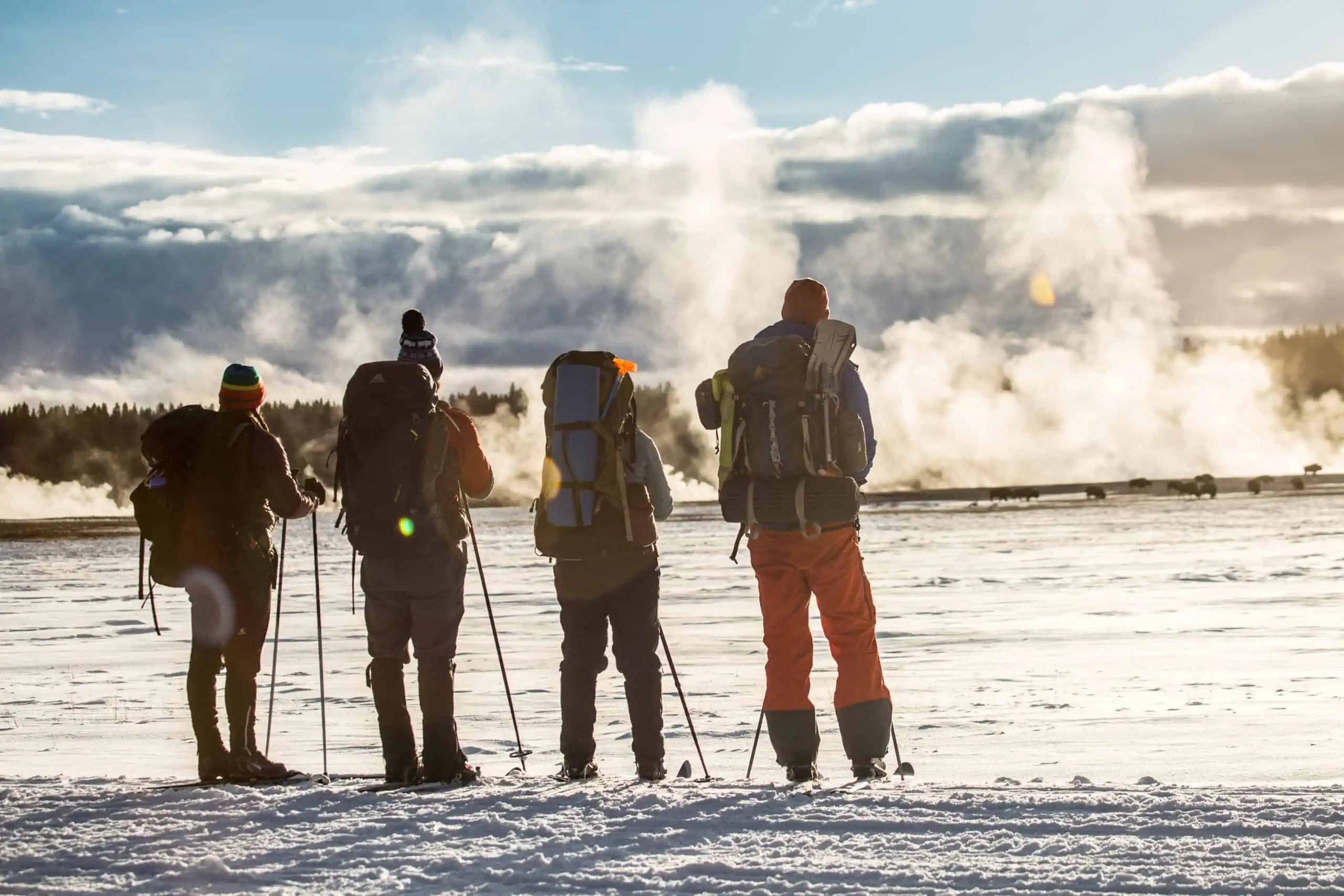Save up to 50% on Yellowstone Hotels
Accommodation is always one of the most expensive items in a national park trip. We want to help! Sign up for free to Parks Channel Member Travel and get up to 50% savings on Yellowstone hotels in gateway cities like Bozeman, MT, and Cody, WY.
How does it work? The site accesses exclusive discounts negotiated by Priceline. We can’t promise that it will always deliver the best possible deal – especially in prime tourist months, or when big events are happening – but in our testing it generated excellent savings on lodgings across the country.
And it’s not just for park travel. Once you’ve signed up, feel free to use the Parks Channel Member Travel site for all your accommodation needs.
Watch We’re in the Rockies Yellowstone Trip Planner for all you need to know about planning a trip to Yellowstone.
Top photo by Dawn Lonczak
5 Best Overlooks in Yellowstone
Yellowstone is a wonderland of natural beauty, with geysers, hot springs, waterfalls, canyons, mountains, valleys and wildlife. There are countless scenic spots in this vast park, but some stand out more than others. Here are the five best overlooks in Yellowstone to admire the stunning landscapes, capture amazing photos and videos, and learn more about the history and geology of the park.
1. Grand Prismatic Overlook and Fairy Falls Trail
The Grand Prismatic Spring is the largest hot spring in the United States and the third largest in the world. It is famous for its vivid colors, which range from blue to green to orange to yellow, depending on the temperature and bacteria in the water. The spring is located in the Midway Geyser Basin, which also features other geothermal features such as the Excelsior Geyser Crater and the Turquoise Pool.
To get a bird’s eye view of the Grand Prismatic Spring and its rainbow-like hues, you need to hike to the Grand Prismatic Overlook. This is a 1.2-mile round-trip hike that starts from the Fairy Falls Trailhead, which is about 1 mile south of Midway Geyser Basin on Grand Loop Road. The trail climbs gradually through a forested area until it reaches a wooden boardwalk that leads to the overlook. From here, you can see the entire spring and its surroundings from above.
You can also continue on the Fairy Falls Trail for another 1.6 miles to reach the Fairy Falls, a 200-foot waterfall that cascades down a rocky cliff.
The best time to visit the Grand Prismatic Overlook is in the morning or evening, when the sun is low and the colors are more vibrant. You should also avoid windy days, as the steam from the spring can obscure your view. The best time of year to visit is in late spring or early summer, when the snow has melted and the wildflowers are blooming.
For the secrets to the extraordinary colors in the Grand Prismatic Spring, check out this short video from Smithsonian Channel’s “Aerial America.”
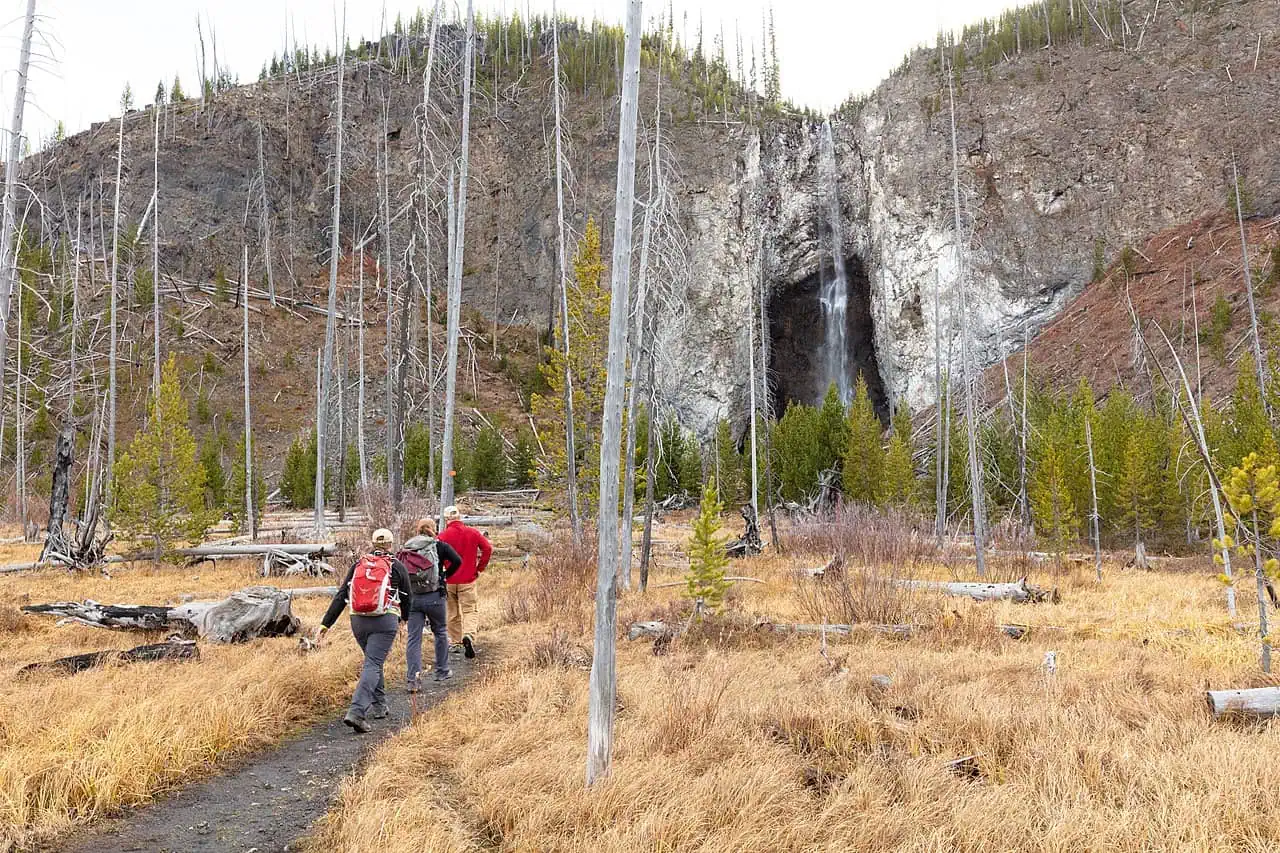
2. Artist Point in Grand Canyon of the Yellowstone
The Grand Canyon of the Yellowstone is one of the most spectacular sights in the park. It is a 20-mile-long canyon that has been carved by the Yellowstone River over millions of years. The canyon walls are made of yellow, orange and red rocks that contrast with the green pine trees and the blue sky. The canyon also features two impressive waterfalls: the Lower Falls and the Upper Falls.
One of the best places to see the canyon and the Lower Falls is from Artist Point. This is a viewpoint that is located on the south rim of the canyon, about 4 miles east of Canyon Village on South Rim Drive. Artist Point offers a panoramic view of the canyon and the 308-foot-tall Lower Falls, which is the tallest waterfall in the park. The viewpoint was named by Frank Jay Haynes, a photographer who visited it in 1883 and was inspired by its beauty.
The best time to visit Artist Point is in late morning or early afternoon, when the sun illuminates the canyon walls and creates a rainbow over the falls. You should also visit in late summer or early fall, when the foliage adds more color to the scene.
Check out this video from We’re in the Rockies for more on the Grand Canyon of the Yellowstone.
3. Mount Washburn
Mount Washburn is one of the highest peaks in Yellowstone, at 10,243 feet above sea level. It is also one of the most accessible mountains in the park, as there are two trails that lead to its summit. From the top, you can enjoy a 360-degree view of the park, including the Grand Tetons, the Absaroka Range, the Yellowstone Lake and the Hayden Valley.
There are two ways to hike to Mount Washburn: from Dunraven Pass or from Chittenden Road. The Dunraven Pass trailhead is located on Grand Loop Road, about 4 miles north of Canyon Village. This trail is 6 miles round-trip and climbs about 1,400 feet. The Chittenden Road trailhead is located on Chittenden Road, which branches off Grand Loop Road about 5 miles north of Canyon Village. This trail is 5 miles round-trip and climbs about 1,300 feet. Both trails are well-maintained and offer scenic views along the way.
The best time to hike to Mount Washburn is in the morning or evening, when the temperature is cooler and the wildlife is more active. You should also hike in late July or August, when the snow has cleared and the wildflowers are blooming. Be prepared for strong winds and sudden weather changes at the summit.
4. Observation Point Trail
The Observation Point Trail is a short but steep hike that leads to a viewpoint overlooking the Old Faithful Geyser and the Upper Geyser Basin. The trail starts from the Old Faithful Visitor Education Center, which is located near the Old Faithful Inn on Grand Loop Road. The trail is 1.1 miles round-trip and climbs about 160 feet.
The Observation Point Trail offers a unique perspective of the Old Faithful Geyser, which is the most famous geyser in the park and one of the most predictable. The geyser erupts about every 90 minutes, shooting water and steam up to 180 feet in the air. From Observation Point, you can see the geyser from above and avoid the crowds that gather around its base. You can also see other geysers and hot springs in the Upper Geyser Basin, such as Castle Geyser, Grand Geyser, and Morning Glory Pool.
The best time to hike to Observation Point is before or after an eruption of Old Faithful, so you can catch the next one from the viewpoint. You should also visit in late spring or early summer, when the snow has melted and the geysers are more active.
5. Brink of the Upper Falls
The Brink of the Upper Falls is a viewpoint that allows you to stand right at the edge of the Upper Falls of the Yellowstone, a 109-foot-tall waterfall that plunges into the Grand Canyon of the Yellowstone. The viewpoint is located on the north rim of the canyon, about 2 miles east of Canyon Village on North Rim Drive. The viewpoint is reached by a short but steep trail that descends about 100 feet.
The Brink of the Upper Falls offers a thrilling experience of the power and beauty of the waterfall. You can feel the spray and hear the roar of the water as it crashes down into the canyon. You can also see the rainbow that forms over the falls when the sun shines on it.
The best time to visit the Brink of the Upper Falls is in midday or afternoon, when the sun is behind you and creates the best lighting for photos and videos. You should also visit in late spring or early summer, when the water flow is at its peak and the falls are most impressive.
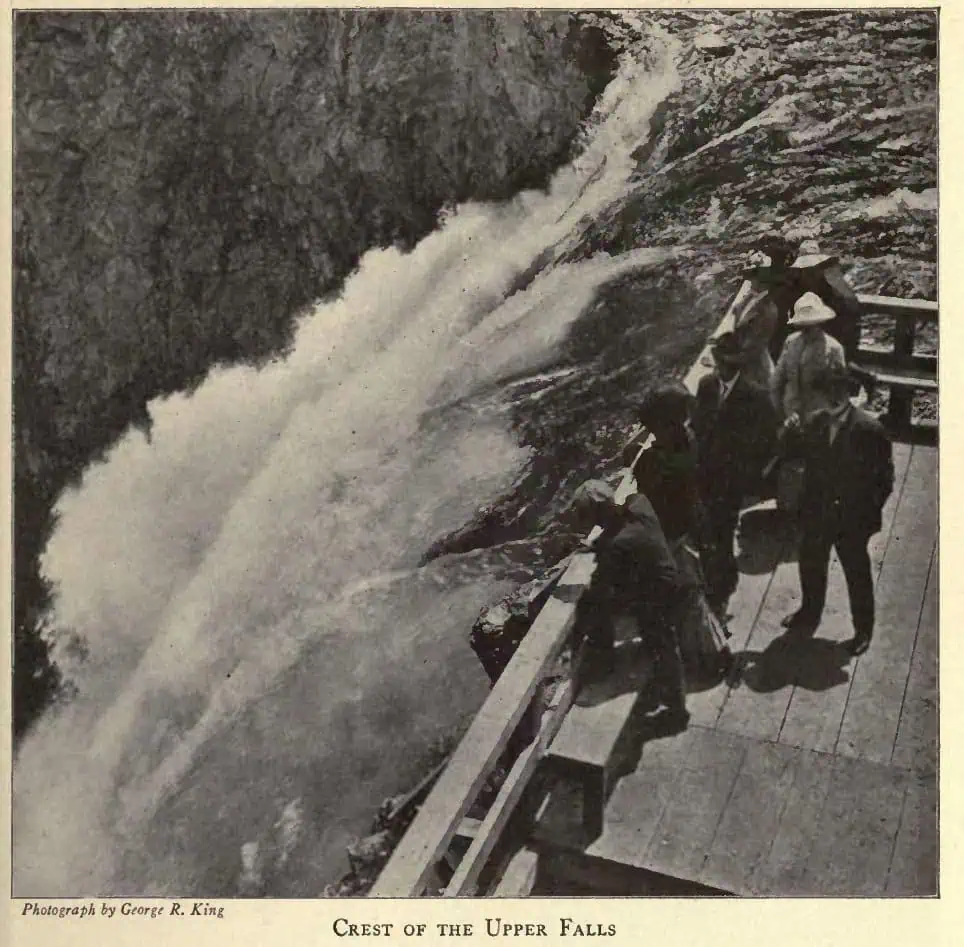
Top photo of Grand Prismatic Spring by Beate Dalbec
The Right Way to Experience Yellowstone is Slowly
Last time we went to Yellowstone was in an aging borrowed RV with squishy brakes. The good news is we never went that fast. There was so much to see, our fellow park goers kept the speed limit to a walking pace. We found the right way to experience Yellowstone is slowly.
You’ll know immediately if there is a bear within a hundred yards. Cars will just stop, creating a “bear jam” that can last until the bears decide to move on. Bison don’t seem to be bothered by cars and freely cross—and often linger—in the middle of the road. It’s a good decision to stay in your car when anything bigger and faster than you is in the vicinity. Best not to risk going viral on social media or worse, not living to regret it.
And why be in a hurry anyway? Nature’s greatest theme park is a spectacle of open plains, forested mountains, deep canyons, cascading waterfalls, explosive geysers, crystal clear hot pools, bubbling cauldrons of mud, scenic lakes and rivers.
Yellowstone is vast, almost 3,500 square miles and it attracts 4 million visitors a year. About half of them will visit between June and August. There are a lot of travel tips on how to avoid the crowds, but going in winter is a good bet to see the fewest people.
Alice Ford went on a bucket list trip to see the wolves of Yellowstone in below-zero temps and lived to tell the tale. Her great adventure is worth a watch.
No matter when you go, you’re going to have to make a plan about where to stay, where to camp, where to eat and what to do. You’ll need to purchase a pass, but you don’t need a reservation to get in. The grand lodges all require reservations up to a year in advance. If you are into camping, there are a dozen campgrounds in the park and you’ll need to make a reservation for them, too. For expert travel advice, Matt and Cheryl of We’re in the Rockies have the best trip planner with tons of useful information.
Yellowstone sits on one of the biggest calderas in the world, the remnant of a supervolcano that is still active but last erupted 70,000 years ago. Legends of dragons drew explorers to Yellowstone Valley, but the Crow believed there was another explanation for what killed the trees and scorched the earth. Grant Bulltail of the Native Memory Project tells the tale.
Today, if you stay on the boardwalks and paths you’ll be fine, just know that in some places the ground below your feet is heated by magma that is turning glacier-temperature water into boiling hot tubs. This makes for quite a show in the upper geyser basin, where Old Faithful, the most famous geyser in the world, can be found. It goes off every 1.5 hours, and the predicted times of launch are posted by the NPS. Half the geysers in the world are here. For what to expect about Old Faithful and how to time your trips, check out Matt’s guide.
There’s plenty of history in Yellowstone, too. If you’re interested in a cautionary tale of what happens if you get lost, there’s the story of Truman C. Everts.
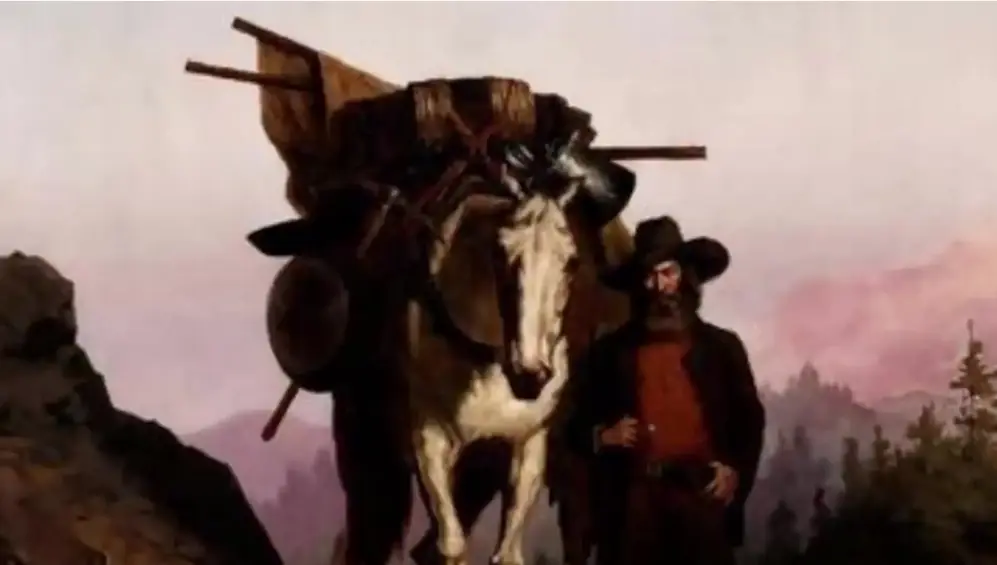
His misadventure is legend, and the History Guy has the story. A gripping tale of a man who lost his bearings, scalded himself in a geyser, started a vast forest fire, hallucinated from hunger and ended up drinking a pint of bear grease to survive.
After a few days hiking through forests yelling “hey bear” to spook the grizzlies, following the Yellowstone River downstream, and crisscrossing the Continental Divide a dozen times, we finally made our way, slowly, out of the park.

Featured photo by Carol M. Highsmith
The Geyser Basins of Yellowstone
More than 10,000 hydrothermal features are active in Yellowstone. Exploring the geyser basins of Yellowstone is an adventure, for beneath this enchanting landscape lies a sleeping giant—a supervolcano—that powers the captivating spectacle.
Yellowstone National Park, a geothermal wonderland, boasts the highest concentration of geothermal features on Earth. The land here smokes, bubbles, and hisses, thanks to the immense volcanic activity beneath its surface. Each of the major geyser basins offers a unique glimpse into the volcanic activity that shapes this iconic park.
1. Mammoth Hot Springs
Mammoth Hot Springs, located in the northern part of the park, is a captivating display of terraces formed by the interaction of hot water and limestone. These terraces resemble cascading white steps, creating an otherworldly landscape. The hot springs deposit approximately two tons of travertine limestone (calcium carbonate) daily, constantly shaping and reshaping the formations.
Wander along the boardwalks that wind through this surreal landscape, where colorful thermophiles thrive in the warm waters. Don’t miss the iconic Minerva Terrace and Palette Spring, which offer some of the most striking views in the area.

2. Norris Geyser Basin
Norris Geyser Basin, the hottest geyser basin in Yellowstone, is a geothermal wonderland. A research drill hole at Norris found a scorching temperature of 459°F (237°C). Within this basin, you’ll encounter steam vents, geysers, hot springs, fumaroles, and mud pots.
Norris is the home of Steamboat Geyser, the tallest geyser in the world, and the Porcelain Springs, with their vibrant colors. Explore the boardwalks and witness the dynamic geothermal activity in this fascinating basin.
Learn more about Norris Geyser Basin from We’re in the Rockies
Yellowstone National Park: How to Visit and What to See by 21st Century Pioneer
3. Mud Volcano
Head east to Mud Volcano, where you’ll encounter a landscape that resembles a scene from another planet. Explore the area’s bubbling mud pots, which emit a pungent odor due to the presence of hydrogen sulfide gas. Marvel at features like Dragon’s Mouth Spring, where water surges from a cavernous opening, creating an eerie roaring sound reminiscent of a mythical creature.
4. West Thumb Geyser Basin
West Thumb Geyser Basin is unique because it lies along the shores of Yellowstone Lake. Imagine geysers and hot springs juxtaposed against the serene blue waters of the lake. The Abyss Pool, with its deep blue hue, is a standout feature. Stroll along the boardwalks that meander around hot springs, geysers, and colorful pools, all set against the backdrop of the vast lake. Keep an eye out for Fishing Cone, a geyser that once served as a makeshift cooking pot for early visitors.
5. Upper Geyser Basin
No visit to Yellowstone would be complete without experiencing the iconic Upper Geyser Basin, home to the world-famous Old Faithful geyser. Arrive early to secure a prime viewing spot for Old Faithful’s predictable eruptions, which occur approximately every 90 minutes. While waiting, explore the surrounding area, which features numerous other geysers and hot springs, including Castle Geyser, Grand Geyser, and Morning Glory Pool. Be sure to check the predicted eruption times for other geysers to maximize your chances of witnessing these natural wonders in action.

6. Midway Geyser Basin
Midway Geyser Basin is home to some of the park’s most visually stunning thermal features. The Grand Prismatic Spring, a massive pool with vivid colors, is the largest hot spring in the U.S. The spring’s rainbow hues result from microbial activity in the water. The boardwalk leads you to the Grand Prismatic Spring Overlook which offers panoramic views of the spring’s vibrant palette and surrounding landscape. And don’t miss the Excelsior Geyser Crater and Turquoise Pool, both of which add to the area’s surreal beauty.

7. Lower Geyser Basin
Conclude your journey at the Lower Geyser Basin, where the geothermal features are as diverse as they are abundant. Covering approximately 11 square miles, the Lower Geyser Basin is the largest geyser basin in Yellowstone. Its thermal features are spread out in widely spaced groups. While it lacks the density of the Upper Geyser Basin, it compensates with its vastness.
Explore the Fountain Paint Pot area, a collection of bubbling mud pots and colorful hot springs named for their resemblance to paint being stirred. Wander among the geysers of the Fountain Group, including Clepsydra Geyser and Fountain Geyser, which boast impressive eruptions against the backdrop of Yellowstone’s wilderness.
Yellowstone’s geyser basins offer a glimpse into truly unique natural phenomena. As you explore these basins, remember that beneath your feet lies a supervolcano, a sleeping giant that powers this geothermal spectacle. Enjoy the magic, but tread lightly on this fragile and dynamic landscape.
Tips for Exploring Yellowstone’s Geyser Basins:
- Safety First: Always stay on designated trails and boardwalks to avoid the fragile thermal features and potential hazards.
- Timing Is Key: Plan your visit to the major geysers for optimal viewing times, and consult the park’s eruption predictions for an enhanced experience.
- Pack Essentials: Bring plenty of water, sunscreen, sturdy footwear, and layers to accommodate Yellowstone’s ever-changing weather.
- Respect Wildlife: Yellowstone is home to diverse wildlife; maintain a safe distance and never feed or approach animals.
- Embrace the Journey: Take your time to soak in the sights, sounds, and smells of Yellowstone’s geyser basins, and savor the wonder of nature’s marvels.
In the photo at the top, steam rises near the Firehole River from geothermal pools and geysers in Yellowstone National Park. (Photo by Cheryl Ramalho)
Secrets to a Magical Winter in Yellowstone
Only a fraction of Yellowstone’s 4 million visitors choose to explore the park in the winter. Although much of the park is shut down with subzero temperatures, it's still worth a visit. Cheryl Schoss of We're In The Rockies offers expert insights for a magical winter in Yellowstone.
Yellowstone’s official winter season usually goes from mid-December through mid-March, depending on the snowpack. Guests can snowmobile, snowshoe, cross-country ski, ice skate, view wildlife, and go on snow coach tours. Yellowstone is so different in the winter, it’s almost like visiting a completely different park. Very few roads within the park are plowed so most visitors work with a tour company to make transportation arrangements via snow coach or snowmobile.
My husband, Matt, and I write travel guides to help people visit the West. We love Yellowstone and visit every year. Last year we visited Yellowstone in February and had a spectacular experience. Read on to learn all about it and see if a trip to Yellowstone in the winter is for you.
When is the Official Winter Season in Yellowstone?
Snow can begin to fall as early as October. The NPS allows the snow to accumulate on most of the roads. From late October through mid-December there aren’t many park services running at all until a good snowpack is formed, making the roads passable for snow coaches and snowmobiles.
All the lodges and restaurants close for the winter except the Old Faithful Snow Lodge and Mammoth Hotel and Cabins. We chose to stay at the Old Faithful Snow Lodge on our last trip and we loved the cute little cabin we stayed in.
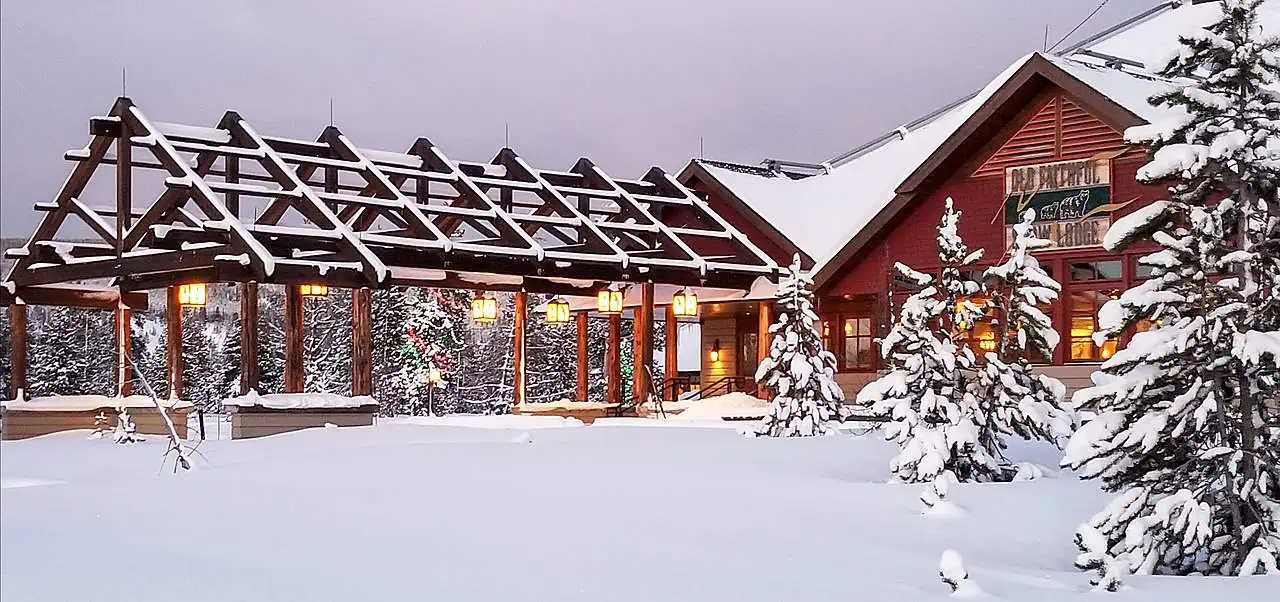
We were pretty shocked that the only place to get dinner there was the Obsidian Dining Room and you needed a reservation for that! The Geyser Grill is open for lunch. The Mammoth area also has a couple of restaurants open.
Gateway towns like West Yellowstone and Gardiner still have plenty of restaurants and hotels open but a lot of their normal tourist services are limited. We were super excited that Melba from Optics Yellowstone in Gardiner agreed to let us rent a scope from her so we could watch wolves (more on that later!)
The NPS begins the herculean task of removing snow from the roads in mid-March and the park is pretty much shut down until they can make the roads passable again. Memorial Day is usually the kick-off for the summer travel season.
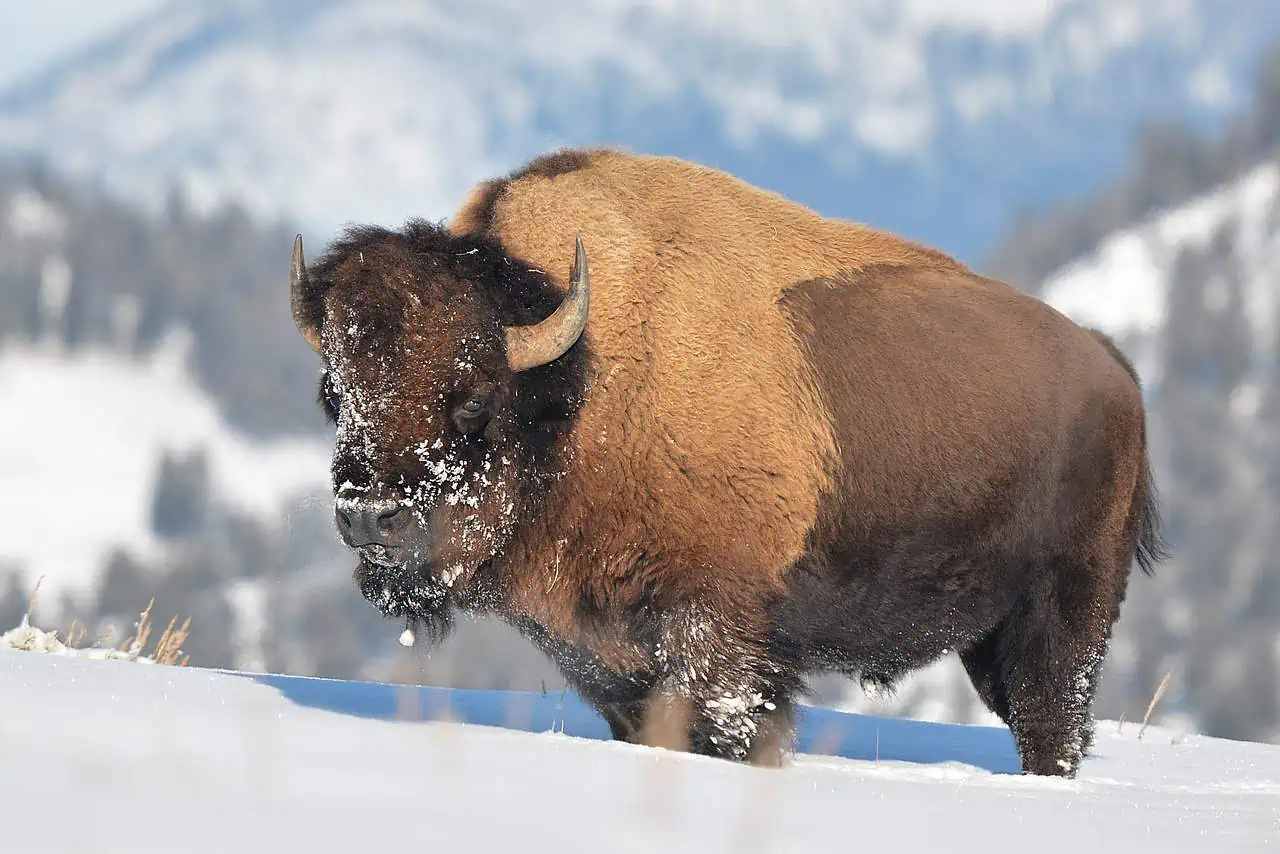
What Are the Road Conditions Like?
Unlike the rest of the park where roads are impassable for all vehicles besides snowmobiles or snow coaches, portions of the Grand Loop Road at the north end of the park and the road to Lamar Valley are plowed throughout winter. The small mountain towns of Cooke City and Silvergate would be cut off from essential services if these roads weren’t regularly cleared.
Both town residents and regular visitors are allowed to access these roads but 4-wheel drive and chains are certainly recommended.
Even with best efforts to keep these roads plowed, a snowstorm can temporarily shut down these roads. The park has very few visitors in the winter and getting stranded on the side of the road in a snowstorm is dangerous because it could be hours before you are found. Always know what the weather forecast is before leaving on an adventure.
How Cold Does It Get?
So cold!! Even though I love Yellowstone, I was a bit gun-shy to make the trip in the winter because the temperatures can range from 0 to -20 degrees Fahrenheit. It really is that cold the entire day, most days.
Matt and I shot a few YouTube videos there and it was hard to talk because our faces were so cold. Holding our cameras with our bare hands was sheer torture! One night I left oranges in our car and woke up to find that my fruit for breakfast had turned into rock-solid iceballs. You get the idea. It’s cold!
We found that the temperatures were more bearable when the sun was out. It was also helpful if we were doing something active, like snowshoeing. It made a big difference. If it was windy or snowing, we tried to get indoors ASAP.
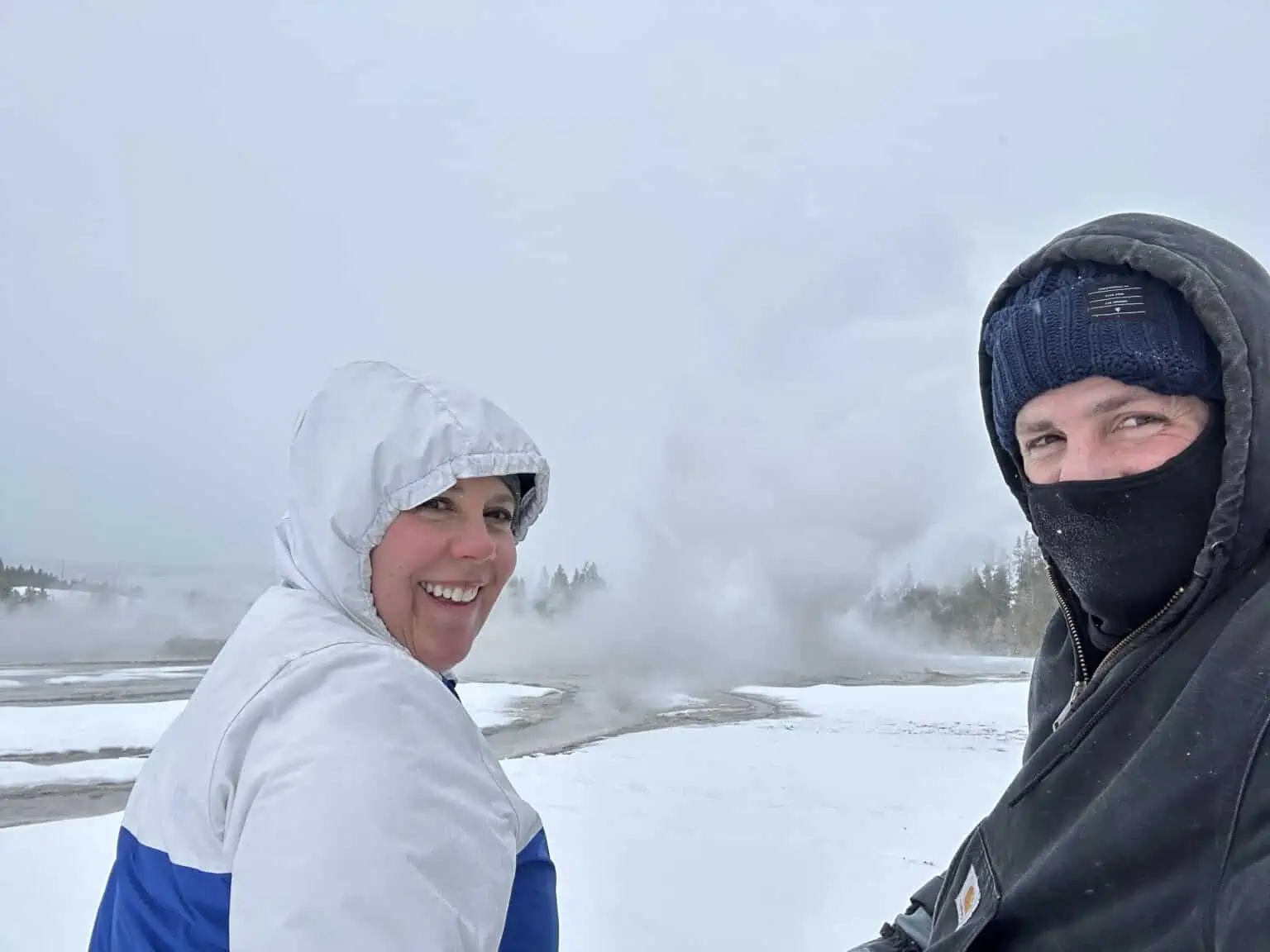
Many guests tour the park from the warmth of a snow coach. After waiting outside for an hour to watch Riverside Geyser erupt, I don’t think that’s a bad idea!
What Parts of Yellowstone Are Closed?
As mentioned earlier, the majority of the park is shut down. This includes campgrounds, hotels and lodges, restaurants, most visitor centers and ranger stations, camp stores, gas stations (you can still pay at the pump at some of them) auto service stations, and medical clinics. If you need any of these services, your best bet is to head to the gateway towns of West Yellowstone or Gardiner, MT.
The winter travel season lasts through mid-March, but services don’t completely open again until Memorial Day and even early June! This is because the NPS has to wait for the snow to melt and clear the roads.
We know several people who tried to visit Yellowstone in early May and had to cut their trip short because of a late snowstorm shutting down the park.
What Parts of Yellowstone Are Open?
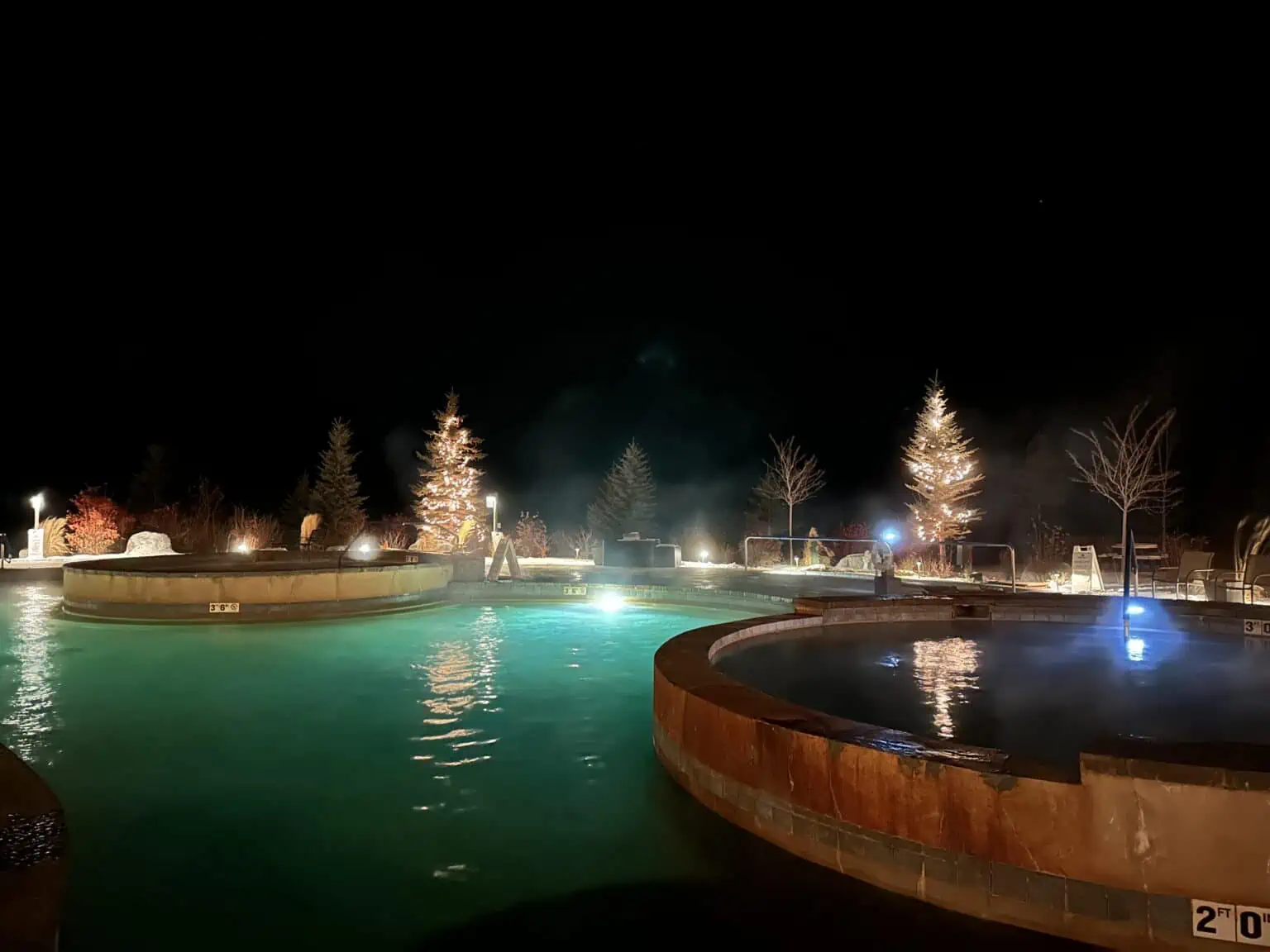
There are actually quite a few places that guests can visit, either in their car or on foot in the town of Mammoth. We enjoyed walking around the Albright Visitor Center and looking at the displays. The Yellowstone Archives are also open. This is a great stop right outside the north entrance of the park if you are into history!
We also soaked in Yellowstone Hot Springs one evening. It’s a beautiful facility that we really want to go back to when we visit in the summer. Even though the water in the springs ranges from 90-100 degrees Fahrenheit, I wore a beanie while in the pools and wore my snow boots with my swimming suit walking to the locker room!
Check out our Complete Guide to Mammoth Hot Springs in Yellowstone for more hot springs nearby.
We were able to walk to the Old Faithful Visitor Center from our cabin at the Old Faithful Snow Lodge.
Bear Den Ski Shops located at both the Mammoth and Old Faithful Snow Lodge are open and rent winter gear such as snowshoes and cross-country skis.
Not sure which Yellowstone Entrance is right for you? Download our Free Quick and Easy Guide to Yellowstone’s Entrances! Get the PDF Now!
Gardiner, MT, and the North Entrance
Gardiner, MT has the most tourist services available of all the gateway towns to Yellowstone. Plenty of locals live here and the roads being plowed allow guests to visit the park without the added expense of booking tours.
Gardiner is charming and we loved our stay at the Yellowstone Gateway Inn. We got a great rate with it being off-season and loved how close it was to everything. We also ate at the Wonderland Cafe, the best restaurant in Yellowstone and the surrounding areas (in our humble opinion!) Matt loves their elk chili.
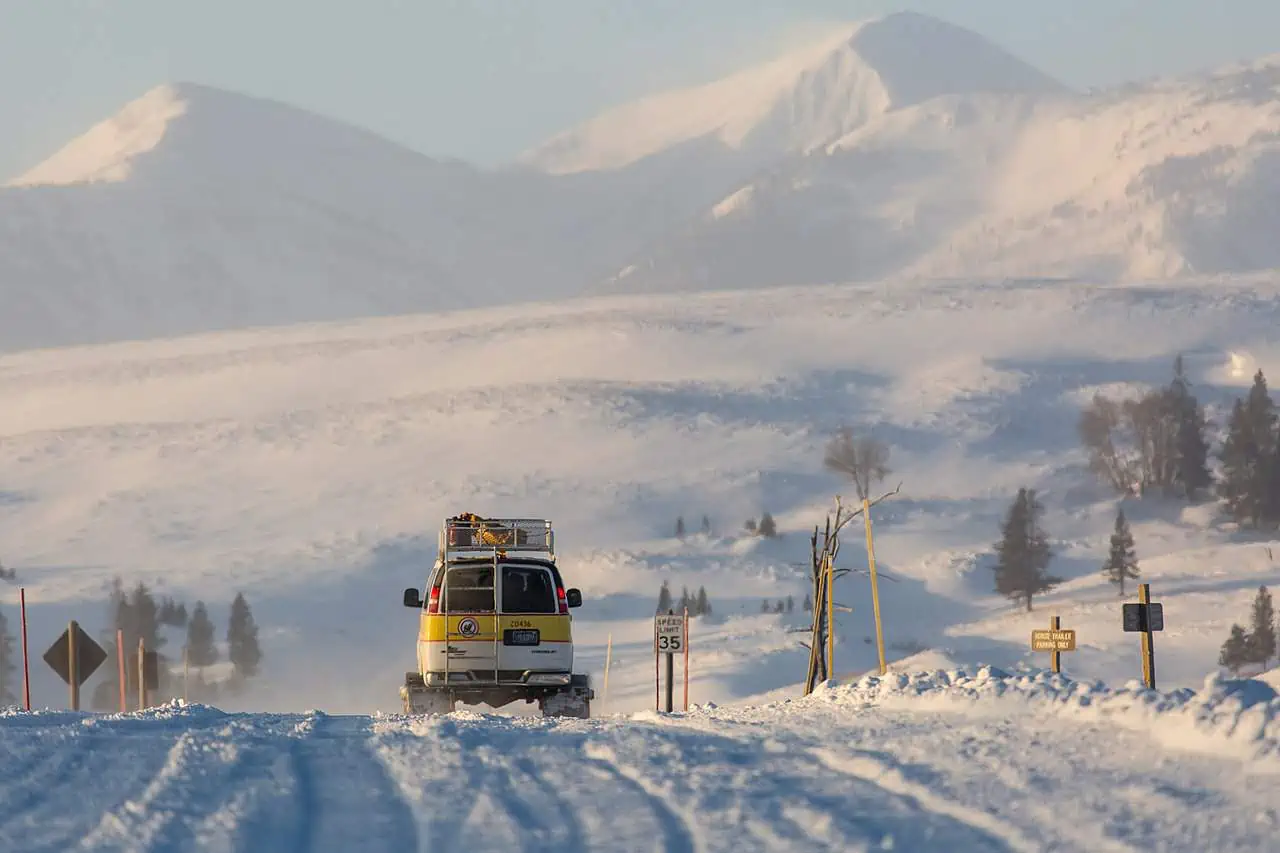

West Yellowstone, MT, and the West Entrance
If you want to see mountains of never-ending snow, look no further than West Yellowstone! Here you can see snow drifts over 6 ft high. Even this small mountain town leaves its roads unplowed to allow snowmobilers easy access to the park.
There are gas stations, hotels, restaurants, and even a few stores open, but you won’t be able to drive your private vehicle into the park. You’ll need a snowmobile or snow coach for that. Guests can also access Yellowstone from the south entrance (Jackson, WY) or the east entrance (Cody, WY) via snow coach or snowmobile.
What Is There To Do?
Our winter trip to Yellowstone was 4 days long (including travel days). We had plenty to do and left feeling like we could have done more. Here are some popular activities guests enjoy at Yellowstone in the winter.
Geysers and Hot Springs
Geysers don’t care if someone is watching or not. They continue to erupt but viewing them is different; Here’s how.
First, the boardwalks to view the geyser basins aren’t cleared. You are literally walking on top of 4 ft of packed snow. At first, I was concerned about this because I liked the guard rails that are normally there to keep me on the path. However, I quickly found that you can tell where the geothermal features are because the snow is melted around them.
Second, the geysers aren’t as pretty. The cold air makes more steam which makes it difficult to distinguish the erupting water from the steam. The springs also lack the bright blue colors they have in the summer. I’m not sure if it’s because the water temperature is cooler, thus allowing the more orange and yellow microorganisms to grow, or if it’s the lack of sunlight creating that pop of color.
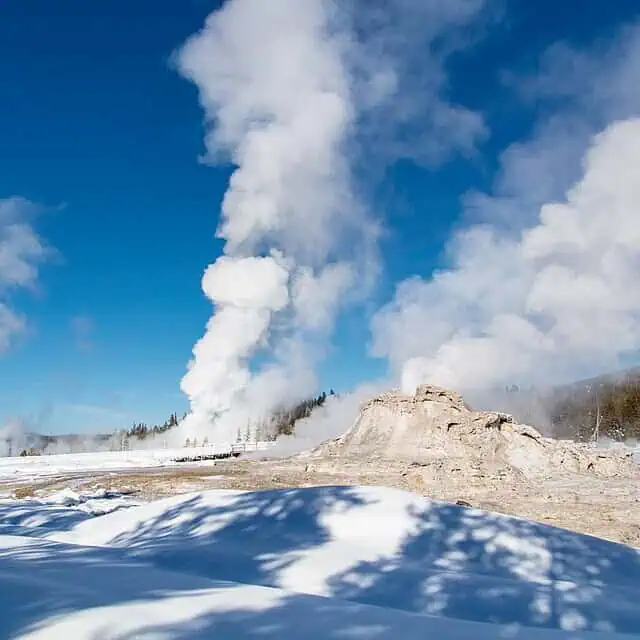
Third, you pretty much get the geysers to yourself. Normally, the Mammoth Terraces are PACKED! Not in winter. We walked around for about 40 minutes and never saw another person.
Tours
There is no shortage of tours available in the winter. They are a necessity if you want to see any part of Yellowstone besides the northern part of the Grand Loop Road. Although there are several private companies that transport guests in and out of Yellowstone and offer tours, Xanterra is the official concessionaire that runs winter tours for Yellowstone National Park.
Tours include options to visit the Grand Canyon of the Yellowstone, Old Faithful Geyser Basin, West Thumb, and wildlife viewing tours. You can check out what they have to offer at the Yellowstone National Park Lodges website.
Tours and shuttle services from private companies depart from West Yellowstone, Jackson, Cody, and Gardiner. Here is the comprehensive list of authorized tour companies.

Cross Country Skiing and Snowshoeing
One thing we have noticed is that Yellowstone is for sightseeing in the summer and recreation in the winter. We met several people who were visiting just because they loved to cross-country ski. There are several packed ski trails throughout the park.
We brought our own snowshoes and blazed a few trails but our favorite was when we went on a guided snowshoe tour from the Old Faithful Snow Lodge. Our guide led us to places that are usually off-limits during the regular travel season and pointed out animal tracks and habitats along the way. It was a delight.
Ice Skating
The Old Faithful Snow Lodge has a very small ice-skating rink out back. It’s a pretty cute little area with a fire pit and Christmas lights. Ice skates are available on the honor system for hotel guests to use.
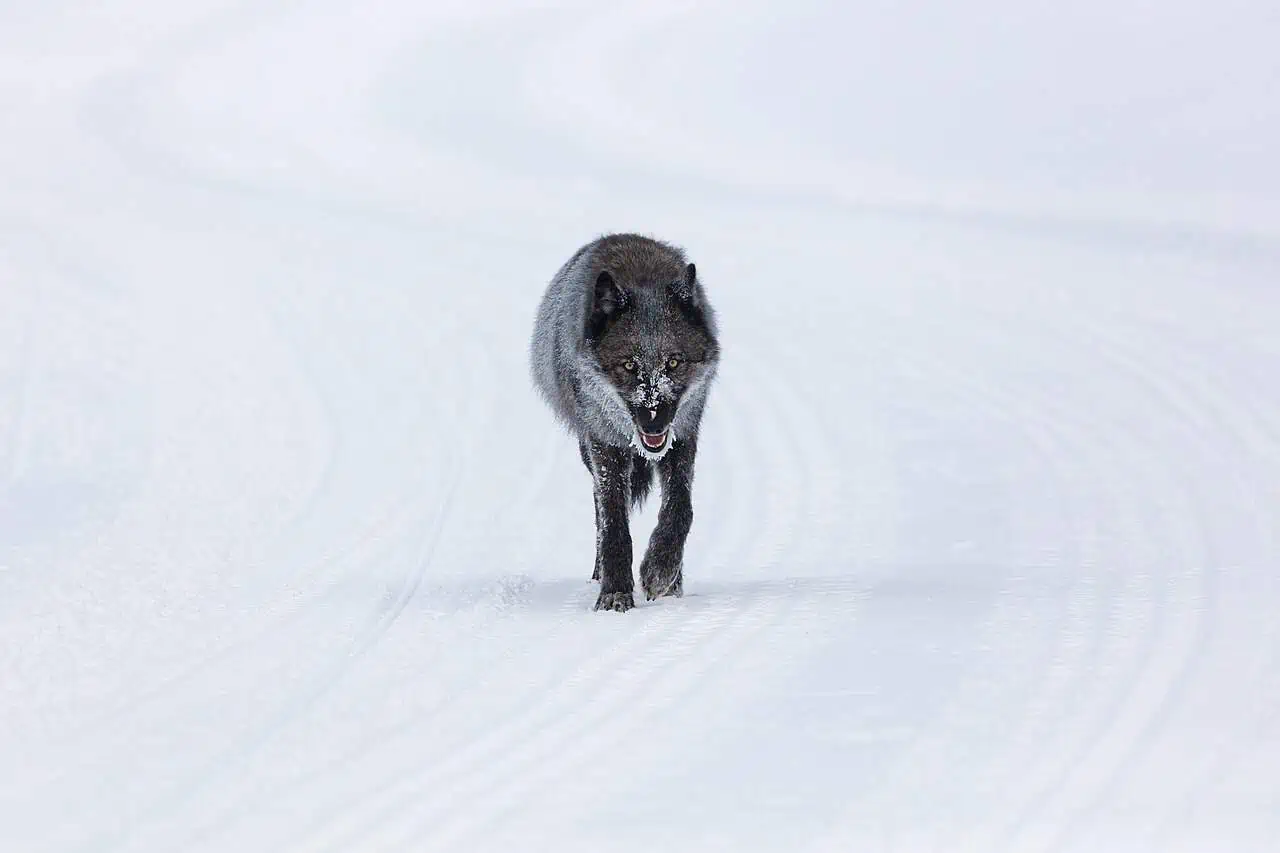
Many other animals, like bison, hang around closer to where people are than usual. Bison are migratory animals and one of the herds actually migrates out of the park and into the city of Gardiner and beyond.
The bison population of Yellowstone has exceeded what the park can support so state and tribal hunts are held during certain parts of the year. We drove a little way out of the park and witnessed one of these hunts. Although we understand this is probably the best solution at the moment, it is still hard to see.
Snowmobiling
This is a huge thing to do and you will see lots of snowmobilers inside and outside of the park. For those who wish to bring their own snowmobile, the park service requires a permit that is given out via lottery system. People wishing to do this can apply in the fall and limited amounts of permits are given. There are also several regulations.
If you aren’t able to get your own permit or would like to do a tour, there are plenty of companies authorized to do this. Check out this comprehensive list of authorized snowmobile tour companies.
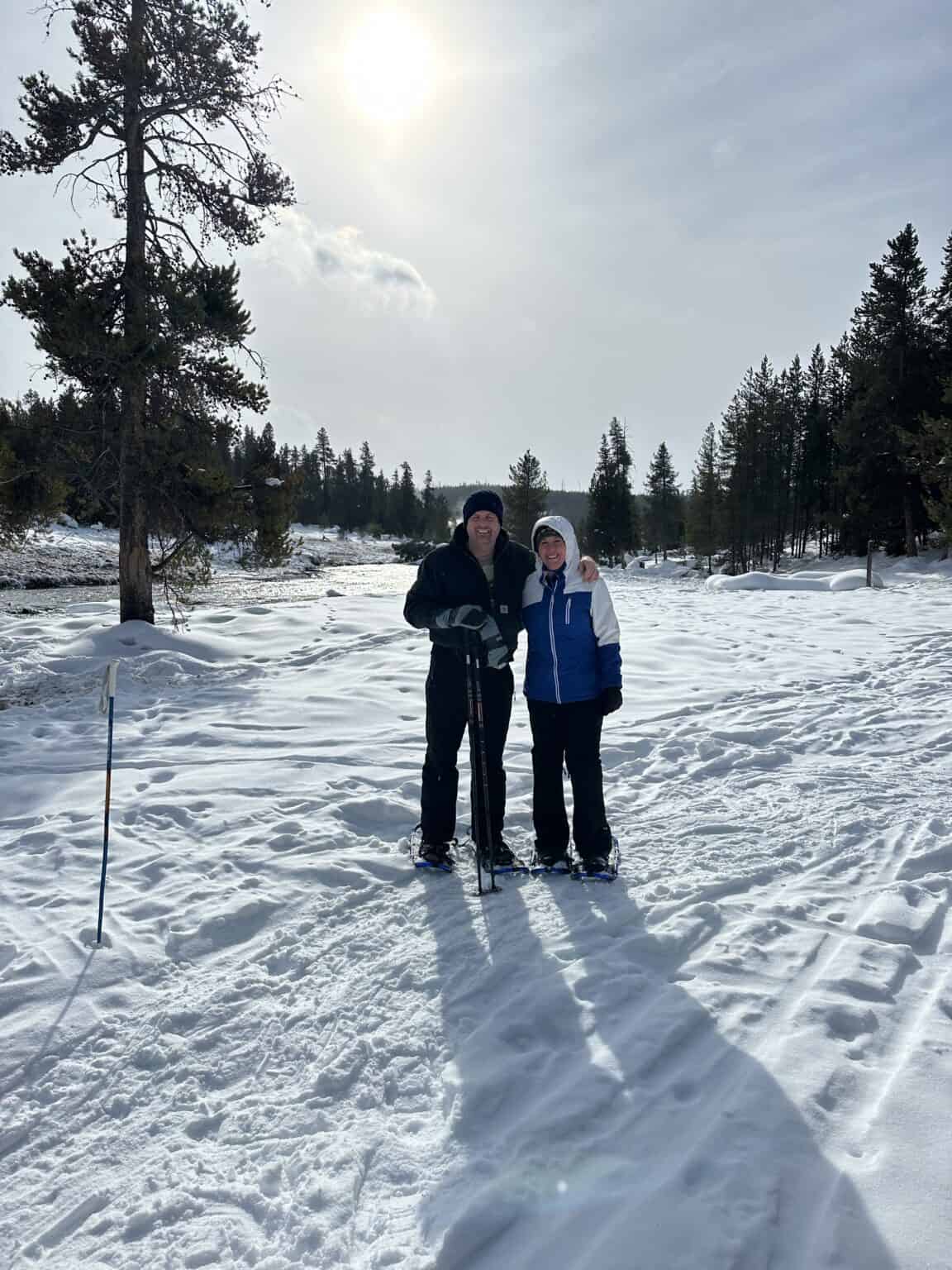
What Kind of Wildlife Can I See?
Winter is a fantastic time to see wildlife in Yellowstone. While visiting the north end of the park, we met several wolf watchers. Every morning they bundle up, grab their scopes, and camp out for the day to watch these amazing animals. We rented a scope and had no idea how to set it up. The kind wolf watchers helped us get the settings just right and we were able to watch a family of wolves just outside their den. It was so cool!

Do I Need a Car?
No. Although we used our vehicle for portions of this trip, both Xantarra and other tour companies have the option of picking guests up directly from the Bozeman airport.
How to Plan For Your Trip to Yellowstone in the Winter
This was a bit more complicated than planning a trip in the summer. One of the biggest obstacles we faced was arranging our snow coach transportation with our in-the-park lodging.
If you go with a private snow coach or snowmobile company (which is often cheaper than Xanterra), you’ll want to make sure there is lodging available within the park between your drop-off and pick-up dates. The best advice we can give is to book your transportation and lodging at the same time.
Also, winter dates are not exact. Mother Nature is the boss here. There is usually enough snow on the road for snow coaches and snowmobiles from mid-December to mid-March, but that is all dependent on snowfall. Book January and February to reduce the risk of cancellation due to road conditions.
Final Thoughts
We are glad we visited Yellowstone in the Winter and we’ll probably visit in the winter again someday. It was NOTHING like visiting in the summer; the park was barely recognizable. Yellowstone in the winter is wonderful for photographers, people who enjoy recreation, people who hate crowds, and wolf watchers. However, if I was only going to make it to Yellowstone once in my life, I would go in the summer because there is so much more to see and do including waterfalls, more geyser basins, getting out on the water, and great outside the park activities.
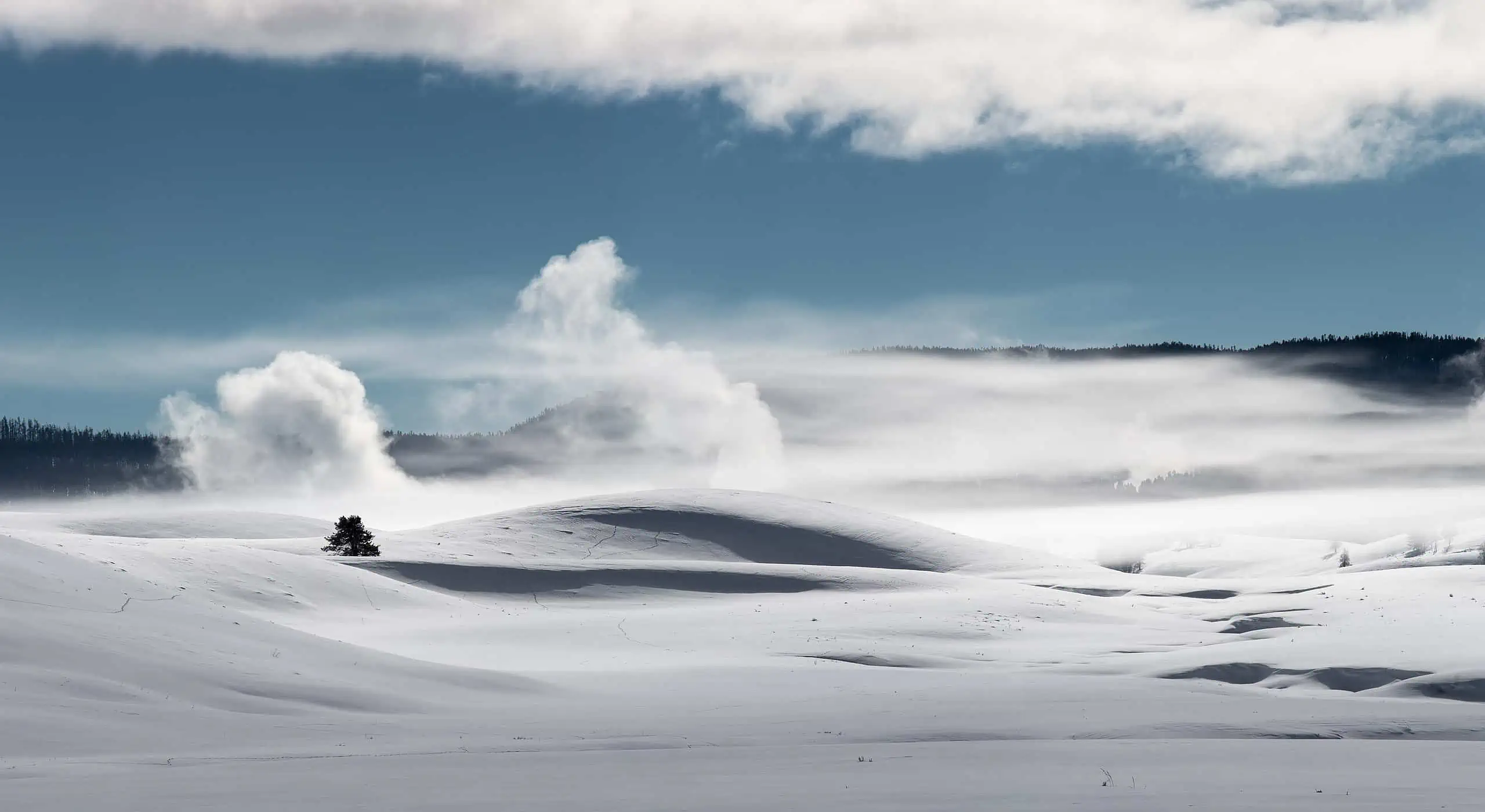
If you are planning to visit Yellowstone in the summer let us help you. Yellowstone is confusing because it’s huge and there are so many things to do!
Need a game plan so you don’t miss out on the best things to do in Yellowstone? Check out our itinerary.
Most travelers want to visit the most popular sites and still avoid the crowds. We have a detailed itinerary that gives you a step-by-step game plan so you can get to the best places at the right times.
Our itinerary includes a free audio guide to listen to while driving with over 3-hours of stories about the park.
Download Your Yellowstone Itinerary
YELLOWSTONE TRIP PLANNER: To read or watch all of our content about Yellowstone National Park, check out our Yellowstone Homepage
ENTRANCES: Yellowstone has 5 entrances: The West Entrance, the East Entrance, the Northeast Entrance, the North Entrance, and the South Entrance. Learn which entrance to Yellowstone is right for you with our Free Quick and Easy Guide
THINGS TO DO: Don’t miss all that Yellowstone has to offer including Old Faithful, the Grand Prismatic Spring, Yellowstone Lake, Norris Geyser Basin, Mammoth Hot Springs, and West Thumb and Grant’s Village
GREAT CITIES TO STAY OR CHECK OUT: Learn all about where to stay and where to camp when visiting Yellowstone and things to do in Cody, Wyoming, and other areas surrounding Yellowstone
WHERE TO EAT: Check out the best places to eat including the Old West Dinner Cookout and also where to get groceries and eat picnics in Yellowstone National Park
KNOW BEFORE YOU GO: Find out if you need a reservation or bear spray and binoculars, as well as tips for driving in and flying to Yellowstone
WATCH: Enjoy videos of gorgeous Yellowstone National Park while learning our best tips for visiting by watching us on The Parks Channel or our Yellowstone YouTube Playlist
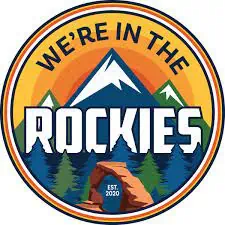
Matt & Cheryl Schoss have been road-tripping in the West and seeing the national parks for more than 20 years, first as students in their home state of Utah, and now with their four kids. They’re both teachers—Matt is an adjunct American history instructor at Weber State University, and Cheryl has taught special education for 25 years. Learn more about them and receive weekly newsletters on the Best of the West including: essential travel tips, park updates, stories, and their favorite things to see and do at https://wereintherockies.com/.
Top photo of skiers in Lower Geyser Basin by Neal Herbert/NPS.

